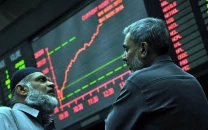Hot money flows - looking beyond temporary relief in Pakistan
Unless savings rate is increased, country is likely to remain in debt trap

PHOTO: REUTERS
It is an achievement for the government in terms of its objectives to curtail the current account deficit, particularly as it faces several challenges on the economic front.
A survey of the summary of balance of payments reported by the State Bank of Pakistan (SBP) indicates a $253-million, or 14%, increase in worker remittances from the value reported in September 2019. The deficit in the balance of trade in goods and services decreased $38 million in October 2019 over September 2019.
Furthermore, a major proportion of foreign portfolio investment and foreign direct investment, reported in the first quarter of FY20, was received in September 2019.
In Pakistan, Islamic banks’ deposits dip due to overregulation
With the ‘hot money’ flow into Pakistan increasing and more expected in the next few months, economic experts have debated its pros and cons. Hot money can provide crucial foreign currency reserves to Pakistan, which is otherwise facing a crisis due to the lack of accumulation of foreign reserves.
It also indicates the confidence of foreign investors as Pakistan tackles its current account deficit and reports a certain level of stability in its currency exchange rate.
On the other hand, the vulnerability of the economy due to the speculative nature of the hot money increases the risk. However, it is important that investor preferences must also be taken into account when discussing the pros and cons.
These preferences include the desire of investors to spread their portfolio across several countries and target specific markets, which can be influenced by the degree of substitutability of different investments when a shock hits global or regional financial markets.
Net foreign currency reserves with the SBP were $7.9 billion in September 2019. In the week ended November 29, 2019, the reserves surpassed $9.1 billion. The net reserves with the SBP increased approximately $750 million in November 2019.
This gain is crucial given that the net foreign reserves at the end of FY19 were $7.3 billion and the total external public debt servicing of Pakistan was $9.65 billion in the year.
Short-term debt
In a sign of vulnerability of Pakistan to speculative attacks or external shocks due to the lack of availability of foreign reserves, the short-term debt as a percentage of gross domestic product (GDP) has risen in volatility over the past 10 years.
Short-term debt is defined as all debt having original maturity of one year or less and interest in arrears on long-term debt. The indicator is extracted from the World Bank’s World Development Indicators.
Between 2003 and 2008, Pakistan reported it at less than 15.2%. However, in 2013, it touched 60.8% and in 2018 it surpassed 70%. Comparatively, the trend in the 1990s was more volatile, peaking at 339% in 1991 and 215.4% in 1996.
Unfortunately, the volatility in this indicator suggests poor management of foreign currency reserves and an increase in dependence on funds from the International Monetary Fund (IMF) to mitigate the volatility.
In comparison, India and Bangladesh report a flatter line with little volatility. It is also important to mention that the short-term debt is less than 10% of the total external debt of Pakistan, while India and Bangladesh maintain higher values.
The total external debt as a percentage of GDP for Pakistan stood at 38.3% on September 30, 2019. Comparatively, India and Bangladesh both report lower levels.
Why is Imran Khan so angry?
Challenges
One of the biggest challenges policymakers face in Pakistan is the low savings rate, which limits the ability to generate domestic savings.
Furthermore, with high dependence on imported intermediate goods and raw material to produce goods for the domestic market, any increase in economic growth is likely to increase the current account deficit and create a vicious cycle, leading to debt trap.
Gross savings, calculated as the disposable income less consumption, as a percentage of GDP in 2018 stood at 18.5% in Pakistan. It was lower relative to 30.9% reported for India and 33.3% reported for Bangladesh.
Low and middle-income countries reported an average of more than 30% in 2017. The lack of savings results in low level of investment and increase in dependence on external sources of finance.
Furthermore, the problem of lack of private investment in Pakistan is exacerbated by the fact that the government itself is a major borrower from domestic financial institutions, crowding out private-sector borrowers.
The Least Developed Countries Report 2019, published by UNCTAD and titled “The present and future of external development finance - old dependence, new challenges”, highlights some of the challenges poorer countries face that lead to a persistent current account deficit.
These include a sluggish structural transformation, high export concentration and high import elasticity of growth.
Although the report specifies the characteristics for the least developed countries, Pakistan reports similar issues.
In terms of import composition, the data extracted from UN Comtrade indicates that a significant proportion of imports into Pakistan are unfinished goods, in the form of intermediate goods and raw material.
However, a closer inspection suggests that approximately 44% of the unfinished goods imported in 2018 were for chemical and allied industries, and base metals, and are mostly consumed domestically.
The export-oriented textile industry imported 12% of the total unfinished goods. Food-related industries reported a similar pattern.
Therefore, imports into Pakistan are likely to be sensitive to economic growth as they primarily cater to the increasing demand in the domestic market. A transformation that entails lower consumption rates is likely to benefit Pakistan tremendously and will provide an impetus to push Pakistan out of the debt trap.
Ultimately, Pakistan has only limited options for tackling the persistent current account deficit. However, one major option it should focus on is to boost exports and ensure that the linkage between imports and exports is better developed.
The relief provided by the hot money inflows is only temporary. Unless Pakistan addresses challenges such as the low savings rate, it is likely to remain in the debt trap.
The writer is the Assistant Professor of Economics and Research Fellow at CBER, IBA
Published in The Express Tribune, December 16th, 2019.
Like Business on Facebook, follow @TribuneBiz on Twitter to stay informed and join in the conversation.



















COMMENTS
Comments are moderated and generally will be posted if they are on-topic and not abusive.
For more information, please see our Comments FAQ